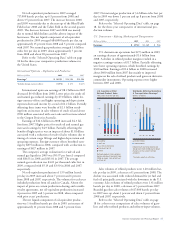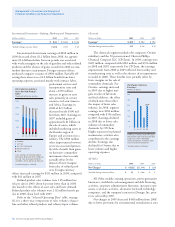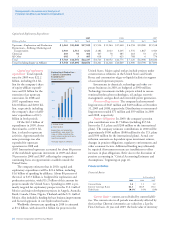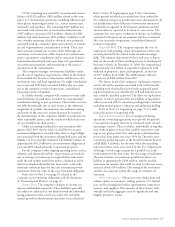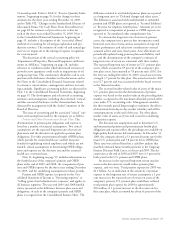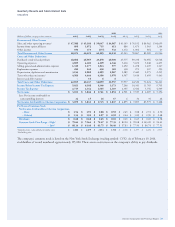Chevron 2009 Annual Report Download - page 25
Download and view the complete annual report
Please find page 25 of the 2009 Chevron annual report below. You can navigate through the pages in the report by either clicking on the pages listed below, or by using the keyword search tool below to find specific information within the annual report.
Chevron Corporation 2009 Annual Report 23
FS-PB
most of which can be liquidated or hedged effectively within
one day. The table below presents the 95 percent/one-day
VaR for each of the company’s primary risk exposures in the
area of derivative commodity instruments at December 31,
2009 and 2008. The lower amounts in 2009 were primarily
associated with a decrease in price volatility for these com-
modities during the year.
Millions of dollars 2009 2008
Crude Oil $ 17 $ 39
Natural Gas 4 5
Refined Products 19 45
Foreign Currency The company may enter into for-
eign-currency derivative contracts to manage some of its
foreign-currency exposures. These exposures include revenue
and anticipated purchase transactions, including foreign-
currency capital expenditures and lease commitments. The
foreign-currency derivative contracts, if any, are recorded at
fair value on the balance sheet with resulting gains and losses
reflected in income. There were no open foreign-currency
derivative contracts at December 31, 2009.
Interest Rates The company may enter into interest rate
swaps from time to time as part of its overall strategy to
manage the interest rate risk on its debt. Historically, under
the terms of the swaps, net cash settlements were based on
the difference between fixed-rate and floating-rate interest
amounts calculated by reference to agreed notional principal
amounts. Interest rate swaps related to a portion of the com-
pany’s fixed-rate debt, if any, may be accounted for as
fair value hedges. Interest rate swaps related to floating-
rate debt, if any, are recorded at fair value on the balance
sheet with resulting gains and losses reflected in income. At
year-end 2009, the company had no interest rate swaps on
floating-rate debt. The company’s only interest rate swaps on
fixed-rate debt matured in January 2009 and the company
had no interest rate swaps on fixed-rate debt at year-end 2009.
Transactions With Related Parties
Chevron enters into a number of business arrangements with
related parties, principally its equity affiliates. These arrange-
ments include long-term supply or offtake agreements and
long-term purchase agreements. Refer to Other Financial
Information in Note 24 of the Consolidated Financial
Statements, page 68, for further discussion. Management
believes these agreements have been negotiated on terms con-
sistent with those that would have been negotiated with an
unrelated party.
Litigation and Other Contingencies
MTBE Chevron and many other companies in the petro-
leum industry have used methyl tertiary butyl ether (MTBE)
as a gasoline additive. Chevron is a party to 50 pending
lawsuits and claims, the majority of which involve numerous
other petroleum marketers and refiners. Resolution of these
lawsuits and claims may ultimately require the company to
correct or ameliorate the alleged effects on the environment
of prior release of MTBE by the company or other parties.
Additional lawsuits and claims related to the use of MTBE,
including personal-injury claims, may be filed in the future.
The company’s ultimate exposure related to pending lawsuits
and claims is not determinable, but could be material to
net income in any one period. The company no longer uses
MTBE in the manufacture of gasoline in the United States.
Ecuador Chevron is a defendant in a civil lawsuit before
the Superior Court of Nueva Loja in Lago Agrio, Ecuador,
brought in May 2003 by plaintiffs who claim to be represen-
tatives of certain residents of an area where an oil production
consortium formerly had operations. The lawsuit alleges
damage to the environment from the oil exploration and
production operations and seeks unspecified damages to fund
environmental remediation and restoration of the alleged
environmental harm, plus a health monitoring program. Until
1992, Texaco Petroleum Company (Texpet), a subsidiary of
Texaco Inc., was a minority member of this consortium with
Petroecuador, the Ecuadorian state-owned oil company, as
the majority partner; since 1990, the operations have been
conducted solely by Petroecuador. At the conclusion of the
consortium and following an independent third-party envi-
ronmental audit of the concession area, Texpet entered into
a formal agreement with the Republic of Ecuador and
Petroecuador for Texpet to remediate specific sites assigned
by the government in proportion to Texpet’s ownership share
of the consortium. Pursuant to that agreement, Texpet conducted
a three-year remediation program at a cost of $40 million.
After certifying that the sites were properly remediated, the
government granted Texpet and all related corporate entities
a full release from any and all environmental liability arising
from the consortium operations.
Based on the history described above, Chevron
believes that this lawsuit lacks legal or factual merit. As to
matters of law, the company believes first, that the court
lacks jurisdiction over Chevron; second, that the law
under which plaintiffs bring the action, enacted in 1999,
cannot be applied retroactively; third, that the claims are
barred by the statute of limitations in Ecuador; and, fourth,
that the lawsuit is also barred by the releases from liability
previously given to Texpet by the Republic of Ecuador and
Petroecuador. With regard to the facts, the company believes
that the evidence confirms that Texpet’s remediation was
properly conducted and that the remaining environmental
damage reflects Petroecuador’s failure to timely fulfill its legal
obligations and Petroecuador’s further conduct since assum-
ing full control over the operations.
In April 2008, a mining engineer appointed by the
court to identify and determine the cause of environmental
damage, and to specify steps needed to remediate it, issued
a report recommending that the court assess $8 billion,
which would, according to the engineer, provide financial
compensation for purported damages, including wrongful
death claims, and pay for, among other items, environmental
remediation, health care systems and additional infrastruc-
ture for Petroecuador. The engineer’s report also asserted that
an additional $8.3 billion could be assessed against Chevron
for unjust enrichment. The engineer’s report is not binding
on the court. Chevron also believes that the engineer’s work




